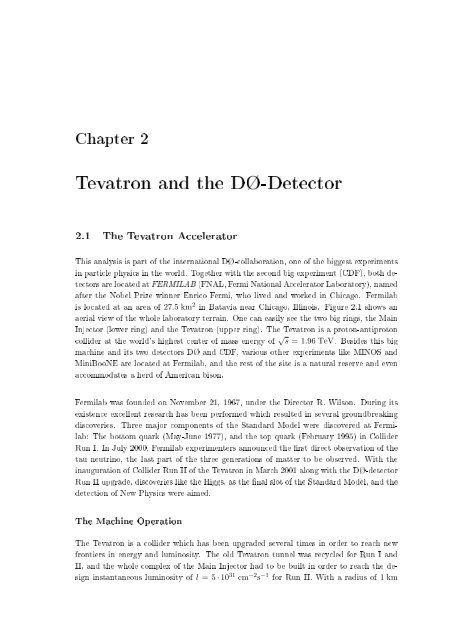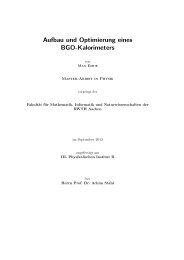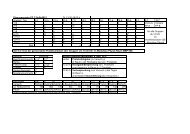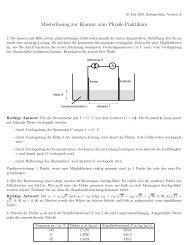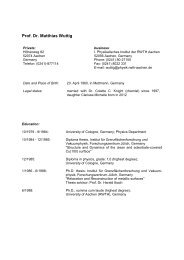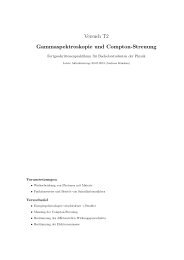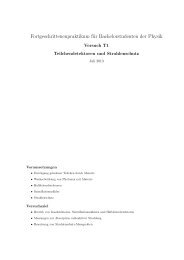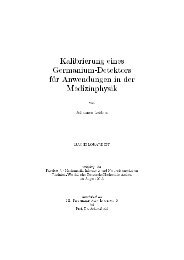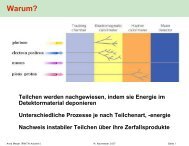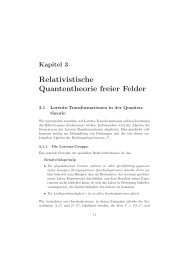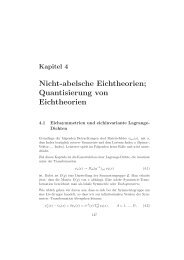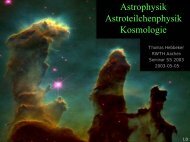Model Independent Search for Deviations from the Standard Model ...
Model Independent Search for Deviations from the Standard Model ...
Model Independent Search for Deviations from the Standard Model ...
You also want an ePaper? Increase the reach of your titles
YUMPU automatically turns print PDFs into web optimized ePapers that Google loves.
Chapter 2<br />
Tevatron and <strong>the</strong> DØ-Detector<br />
2.1 The Tevatron Accelerator<br />
This analysis is part of <strong>the</strong> international DØ-collaboration, one of <strong>the</strong> biggest experiments<br />
in particle physics in <strong>the</strong> world. Toge<strong>the</strong>r with <strong>the</strong> second big experiment (CDF), both detectorsarelocatedat<br />
FERMILAB(FNAL,FermiNationalAcceleratorLaboratory),named<br />
after <strong>the</strong> Nobel Prize winner Enrico Fermi, who lived and worked in Chicago. Fermilab<br />
is located at an area of 27.5 km in Batavia near Chicago, Illinois. Figure 2.1 shows an<br />
aerial view of <strong>the</strong> whole laboratory 2 terrain. One can easily see <strong>the</strong> two big rings, <strong>the</strong> Main<br />
Injector (lower ring) and <strong>the</strong> Tevatron (upper ring). The Tevatron is a proton-antiproton<br />
collider at <strong>the</strong> world's highest center of mass energy of √ s = 1.96 TeV. Besides this big<br />
machine and its two detectors DØ and CDF, various o<strong>the</strong>r experiments like MINOS and<br />
MiniBooNE are located at Fermilab, and <strong>the</strong> rest of <strong>the</strong> site is a natural reserve and even<br />
accommodates a herd of American bison.<br />
Fermilab was founded on November 21, 1967, under <strong>the</strong> Director R. Wilson. During its<br />
existence excellent research has been per<strong>for</strong>med which resulted in several groundbreaking<br />
discoveries. Three major components of <strong>the</strong> <strong>Standard</strong> <strong>Model</strong> were discovered at Fermilab:<br />
The bottom quark (May-June 1977), and <strong>the</strong> top quark (February 1995) in Collider<br />
Run I. In July 2000, Fermilab experimenters announced <strong>the</strong> rst direct observation of <strong>the</strong><br />
tau neutrino, <strong>the</strong> last part of <strong>the</strong> three generations of matter to be observed. With <strong>the</strong><br />
inauguration of Collider Run II of <strong>the</strong> Tevatron in March 2001 along with <strong>the</strong> DØ-detector<br />
Run II upgrade, discoveries like <strong>the</strong> Higgs, as <strong>the</strong> nal slot of <strong>the</strong> <strong>Standard</strong> <strong>Model</strong>, and <strong>the</strong><br />
detection of New Physics were aimed.<br />
The Machine Operation<br />
The Tevatron is a collider which has been upgraded several times in order to reach new<br />
frontiers in energy and luminosity. The old Tevatron tunnel was recycled <strong>for</strong> Run I and<br />
II, and <strong>the</strong> whole complex of <strong>the</strong> Main Injector had to be built in order to reach <strong>the</strong> design<br />
instantaneous luminosity of l = 5 · 10 31 cm −2 s <strong>for</strong> Run II. With a radius of −1 1 km


